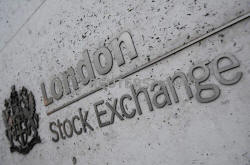Global shares begin second half with a whimper despite
positive data
 Send a link to a friend
Send a link to a friend
 [July 01, 2020] By
Tom Arnold [July 01, 2020] By
Tom Arnold
LONDON (Reuters) - Global stocks bogged
down in worries about surging coronavirus cases in the United States on
Wednesday, even as a slew of data hinted at signs of an economic
recovery in Europe and Asia.
Germany's manufacturing sector contracted at a slower pace in June,
while French factory activity rebounded into growth, data showed.
German retail sales rose sharply in May, reflecting a rebound in private
consumption, while a recovery in China's factory activity offered
further signs that the world's second largest economy may have passed
the worst of the devastation caused by the pandemic.
Germany's jobless rate rose by 69,000 in June, far less than expected.
Economic institute Ifo said Europe's largest economy will gradually
recover after the slump caused by the pandemic and probably return to
last year's level at the end of 2021.
Coronavirus cases surged, with the United States recording 47,000 new
infections on Tuesday, its biggest single-day spike since the pandemic
began.

MSCI's world shares index was 0.2% weaker after rising 18% for its
biggest three-month gain since 2009 in the second quarter, but it still
closed the first half around 8% lower from where it started the year.
After their best quarter since March 2015, European stocks turned
negative, with the broader Euro STOXX 600 ebbing 0.7%.
"We are at the beginning of the quarter but it doesn't look very
different from where we left the last one," said François Savary, chief
investment officer at Swiss wealth manager Prime Partners, predicting "a
further consolidation over the summer".
MSCI's broadest index of Asia-Pacific shares outside Japan rose 0.4%,
led by gains in China. E-Mini futures for the S&P 500 were down 0.6%.
This followed a strong finish to the quarter on Wall Street but also a
loss of momentum in recent weeks as U.S. COVID-19 infection rates have
surged, with some states reimposing restrictions on business and
personal activity.
The S&P 500 index rose 1.5% for an almost 20% gain over the past three
months, fuelled by unprecedented central bank stimulus and hopes for a
swift pandemic recovery, but it rose only 1.8% in June.
Coronavirus cases more than doubled in 14 U.S. states last month, a
Reuters analysis showed, and fears are growing that the caseload could
prompt fresh lockdowns.
[to top of second column] |

The London Stock Exchange Group offices are seen in the City of
London, Britain, December 29, 2017. REUTERS/Toby Melville/File Photo

"The rise in COVID-19 infections is now triggering a reversal on the reopening
strategy," said Rodrigo Catril, senior FX strategist at National Australia Bank
in Sydney. "It remains to be seen if the U.S economy will continue to surprise
over the coming month."
The U.S. government bond market remains in a cautious mood. Yields on benchmark
10-year government debt rose overnight to 0.6774%, but finished the quarter
steady.
In Europe, Germany's 10-year yield rose to a one-week high, rising 2 basis
points on the day to -0.44, helped by better than expected German retail sales.
UNWELCOME DEVELOPMENTS
China's introduction of sweeping new laws to crack down on dissent in Hong Kong
also has investors eying geopolitical tensions with trepidation.
The laws have prompted fresh protests in the city and Washington has begun
dismantling Hong Kong's special status under U.S. law.
"It's one of a number of geopolitical factors which is a negative for some asset
classes now," said Imre Speizer, a foreign exchange strategist at Westpac in
Auckland.
Currency markets were in a holding pattern before the next slew of data due to
provide a snapshot of the U.S. recovery.
The dollar strengthened before U.S. manufacturing PMI and unemployment data. The
euro fell 0.4% versus the dollar to $1.11900 .
U.S. manufacturing activity data on Wednesday is forecast to show a recovery
from an 11-year low in April while the non-farm payrolls report on Thursday is
expected to show the economy added 3 million jobs in June.

Gold prices rose to their highest in 8 years at $1,788.96 an ounce, before
easing back slightly.
Brent crude rose 2.0% to $42.10 a barrel, while U.S. crude was up 2.1% at $40.10
a barrel, helped by the positive manufacturing data and an industry report
showed crude stockpiles in the U.S. staged a bigger drop than expected.
(Additional reporting by Shriya Ramakrishnan in Bengaluru; Editing by Timothy
Heritage/Mark Heinrich)
[© 2020 Thomson Reuters. All rights
reserved.] Copyright 2020 Reuters. All rights reserved. This material may not be published,
broadcast, rewritten or redistributed.
Thompson Reuters is solely responsible for this content. |